1995 CHEVROLET TAHOE Recommended fluid
[x] Cancel search: Recommended fluidPage 344 of 486

Downloaded from www.Manualslib.com manuals search engine Glass
Glass should be cleaned often. GM Glass Cleaner (GM Part No. 1050427)
or a liquid household glass cleaner will remove normal tobacco smoke and
dust films.
Don’t use abrasive cleaners
on glass, because they may cause scratches.
Avoid placing decals on the inside rear window, since
they may have to be
scraped off later. If abrasive cleaners are used on
the inside of the rear
window, an electric defogger element may be damaged. Any temporary
license should not be attached across the defogger grid.
Cleaning the Outside of the Windshield,
Backglass and Wiper Blades
If the windshield is not clear after using the windshield washer, or if the
wiper blade chatters when running, wax or other material may be on the
blade
or windshield.
Clean the outside
of the windshield with GM Windshield Cleaner, Bon-Ami
Powder@
(GM Part No. 10500 I 1 ). The windshield is clean if beads do not
form when you rinse it with water.
Clean the blade by wiping vigorously with a cloth soaked
in full strength
windshield washer solvent. Then rinse the blade with water.
Wiper blades should be checked on a regular basis and replaced when worn.
Weatherstrips
Silicone grease on weatherstrips will make them last longer, seal better, and
not stick or squeak. Apply silicone grease with a clean cloth
at least every
six months. During very cold, damp weather more frequent application may
be required. (See “Recommended Fluids and Lubricants”
in the Index.)
Cleaning the Outside of Your Vehicle
The paint finish on your vehicle provides beauty, depth of color, gloss
retention and durability.
6-67
Page 364 of 486

Downloaded from www.Manualslib.com manuals search engine Scheduled Maintenance Services
IMPORTANT:
KEEP ENGINE OIL
AT THE PROPER
LEVELAND CHANGE
AS RECOMMENDED
Section
7
This section covers the maintenance required for your vehicle. Your vehicle
needs these services
to retain its safety, dependability and emission control
performance.
GM -
lo
Protection
Have you purchased the GM Protection Plun? The Plun supplements your
new vehicle warranties. See your GM dealer for detui1.s.
Introduction
Your Vehicle and the Environment
Proper vehicle maintenance not only helps to keep your vehicle in good
working condition, but also helps
the environment. All recommended
maintenance procedures are important. Improper vehicle maintenance or the
removal
of important components can significantly affect the quality of the
air we breathe. Improper fluid levels or even
the wrong tire inflation can
increase the level
of emissions from your vehicle. To help protect our
environment, and
to help keep your vehicle in good condition, please
maintain your vehicle properly.
7- 1
Page 365 of 486
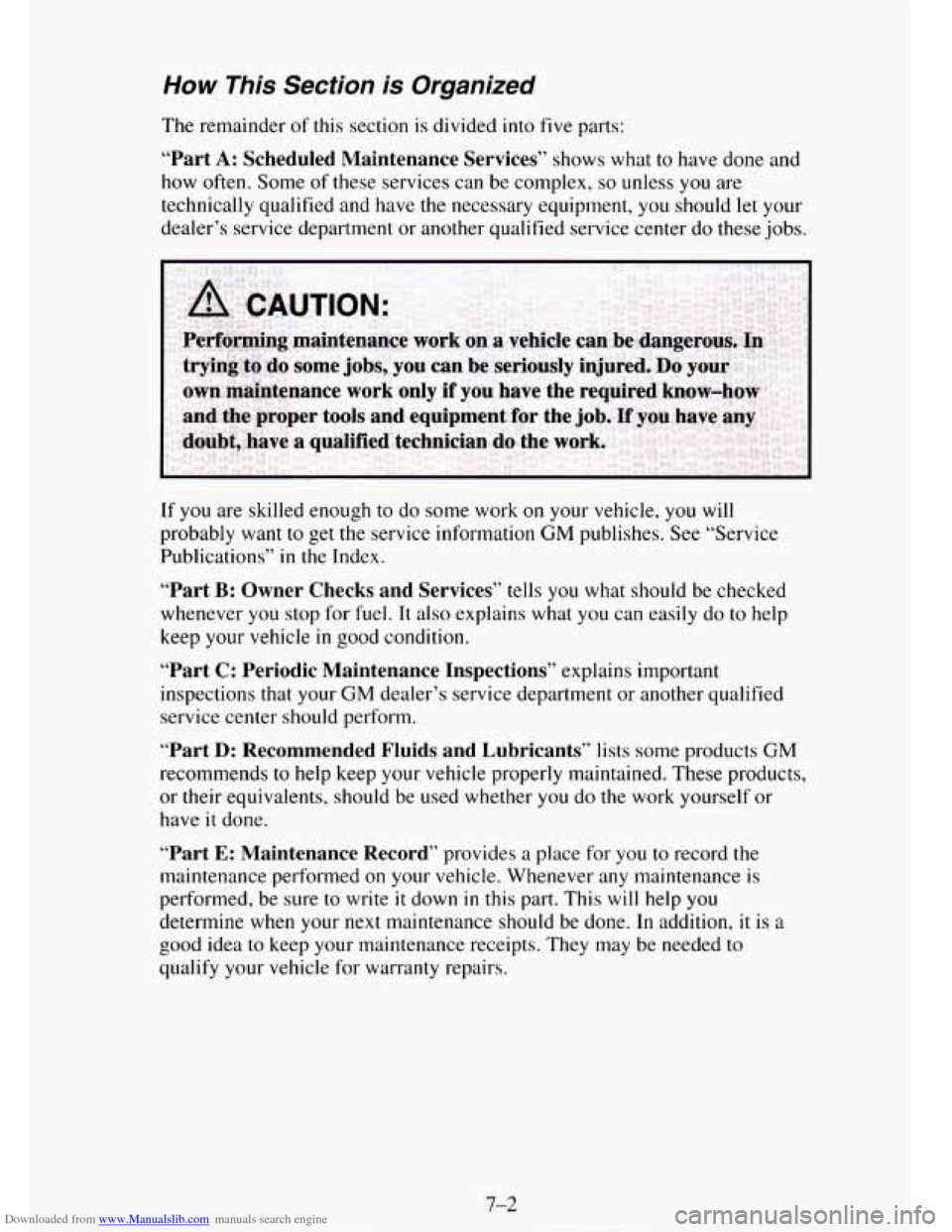
Downloaded from www.Manualslib.com manuals search engine How This Section is Organized
The remainder of this section is divided into five parts:
“Part A: Scheduled Maintenance Services” shows what to have done and
how often. Some of these services can be complex,
so unless you are
technically qualified and have
the necessary equipment, you should let your
dealer’s service department or another qualified service center do these jobs.
If you are skilled enough to do some work on your vehicle, you will
probably want
to get the service information GM publishes. See “Service
Publications”
in the Index.
“Part B: Owner Checks and Services” tells you what should be checked
whenever you stop for fuel. It also explains what you can easily do
to help
keep your vehicle
in good condition.
“Part C: Periodic Maintenance Inspections” explains important
inspections that your
GM dealer’s service department or another qualified
service center should perform.
“Part D: Recommended Fluids and Lubricants” lists some products GM
recommends to help keep your vehicle properly maintained. These products,
or their equivalents, should be used whether
you do the work yourself or
have it done.
“Part E: Maintenance Record” provides a place for you to record the
maintenance performed
on your vehicle. Whenever any maintenance is
performed, be sure to write
it down in this part. This will help you
determine when your next maintenance should be done. In addition,
it is a
good idea to keep your maintenance receipts. They may be needed to
qualify your vehicle
for warranty repairs.
7-2
Page 366 of 486
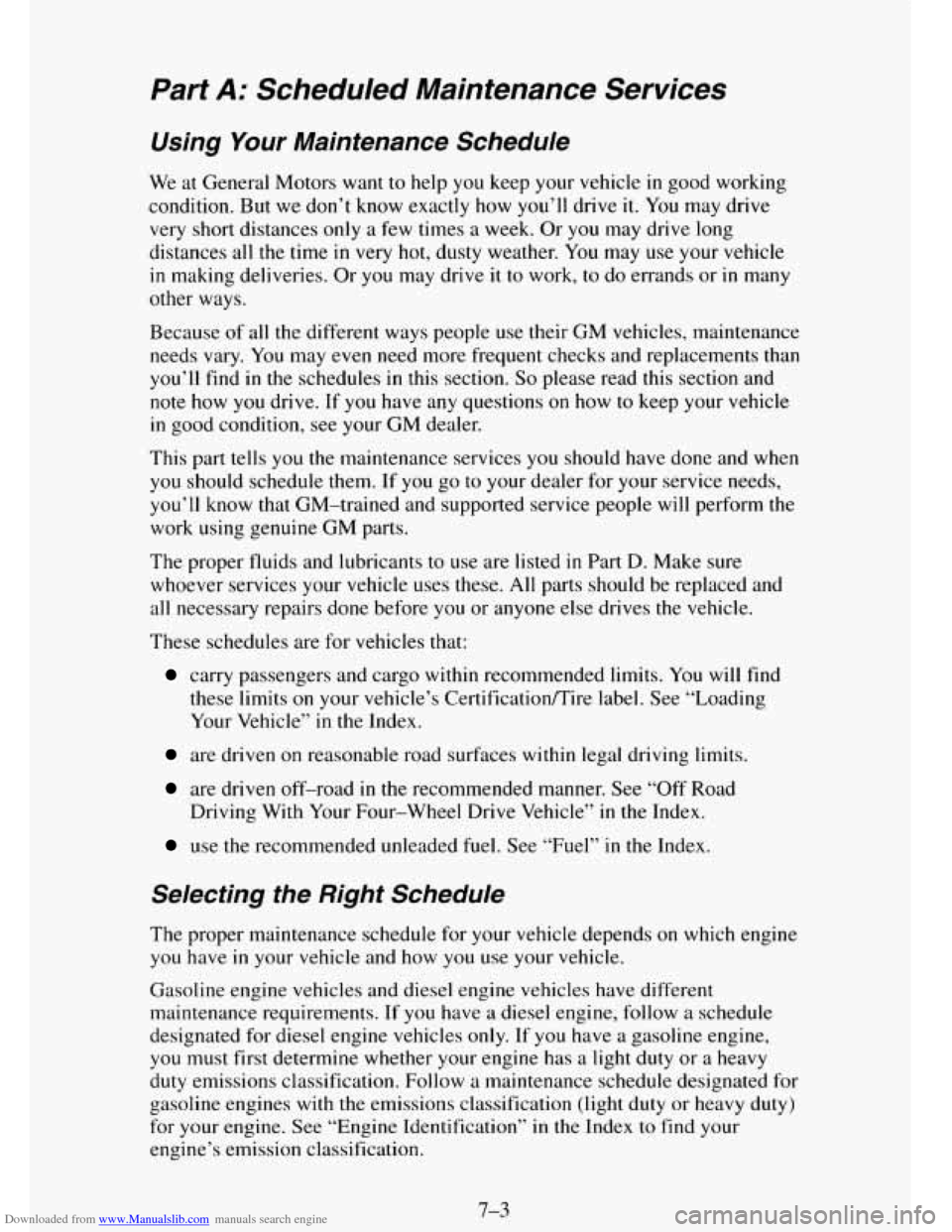
Downloaded from www.Manualslib.com manuals search engine Part A: Scheduled Maintenance Services
Using Your Maintenance Schedule
We at General Motors want to help you keep your vehicle in good working
condition. But we don’t know exactly how
you’ll drive it. You may drive
very short distances
only a few times a week. Or you may drive long
distances all the time
in very hot, dusty weather. You may use your vehicle
in making deliveries. Or you may drive it to work, to do errands or in many
other ways.
Because of all the different ways people use their GM vehicles, maintenance
needs vary. You may
even need more frequent checks and replacements than
you’ll find
in the schedules in this section. So please read this section and
note how
you drive. If you have any questions on how to keep your vehicle
in good condition, see your GM dealer.
This part tells you the maintenance services
you should have done and when
you should schedule them. If you go to your dealer for your service needs,
you’ll know that GM-trained and supported service people will perform the
work using genuine GM parts.
The proper fluids and lubricants to use are listed in Part D. Make sure
whoever services your vehicle uses these. All parts should be replaced and
all necessary repairs done before you or anyone else drives the vehicle.
These schedules are
for vehicles that:
carry passengers and cargo within recommended limits. You will find
these limits on your vehicle’s CertificatiodTire label. See “Loading
Your Vehicle”
in the Index.
are driven on reasonable road surfaces within legal driving limits.
are driven off-road in the recommended manner. See “Off Road
Driving With Your Four-wheel Drive Vehicle”
in the Index.
use the recommended unleaded fuel. See “Fuel” in the Index.
Selecting the Right Schedule
The proper maintenance schedule for your vehicle depends on which engine
you have in your vehicle and how you use your vehicle.
Gasoline engine vehicles and diesel engine vehicles have different
maintenance requirements. If you have a diesel engine, follow
a schedule
designated for diesel engine vehicles
only. If you have a gasoline engine,
you must first determine whether your engine has a light duty or a heavy
duty emissions classification. Follow a maintenance schedule designated for
gasoline engines with the emissions classification (light duty or heavy duty)
for your engine. See “Engine Identification”
in the Index to find your
engine’s emission classification.
7-3
Page 375 of 486
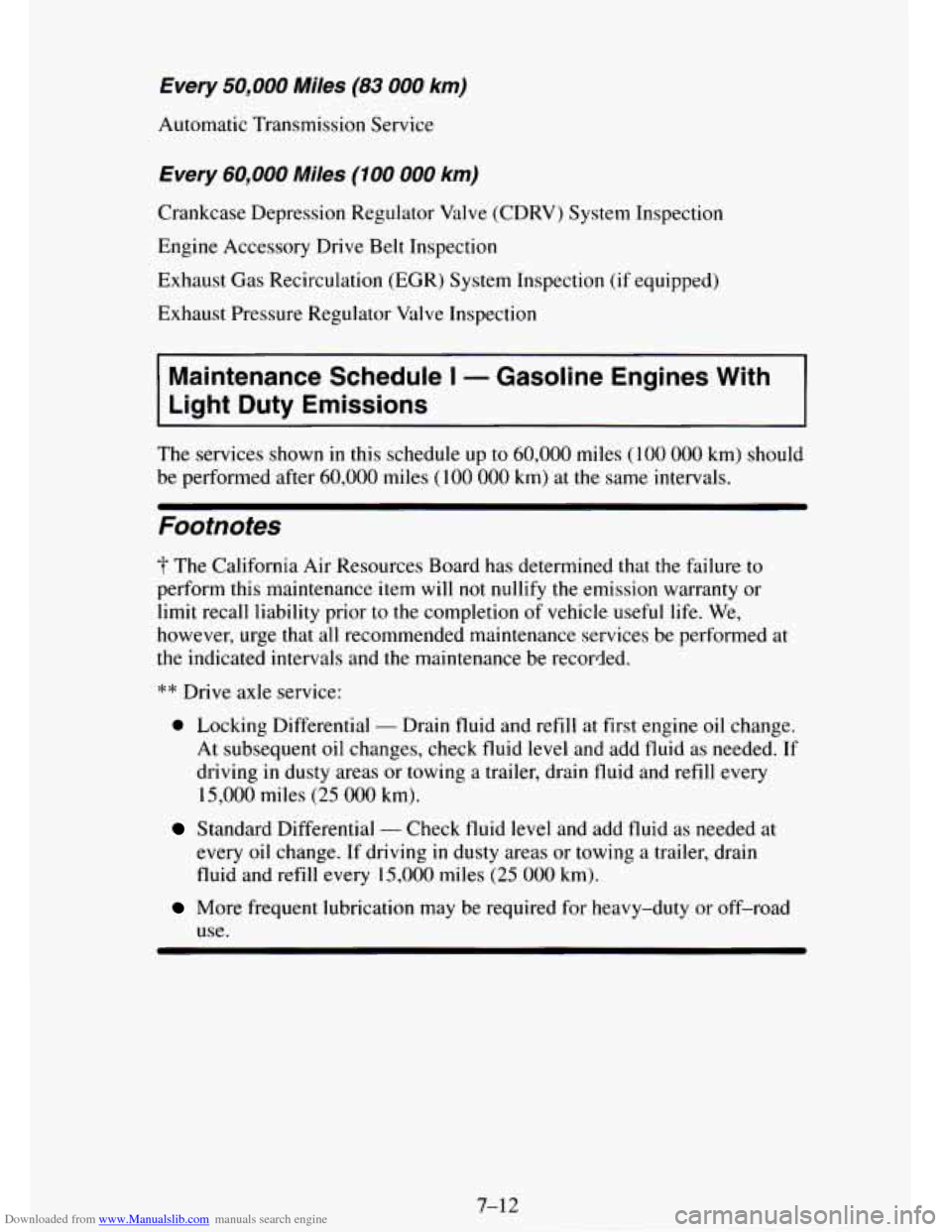
Downloaded from www.Manualslib.com manuals search engine Every 50,000 Miles (83 000 km)
Automatic Transmission Service
Every 60,000 Miles (100 000 km)
Crankcase Depression Regulator Valve (CDRV) System Inspection
Engine Accessory Drive Belt Inspection
Exhaust Gas Recirculation (EGR) System Inspection
(if equipped)
Exhaust Pressure Regulator Valve Inspection
Maintenance Schedule I - Gasoline Engines With
Light Duty Emissions
The services shown in this schedule up to 60,000 miles (100 000 km) should
be performed after
60,000 miles (100 000 km) at the same intervals.
Footnotes
The California Air Resources Board has determined that the failure to
perform this maintenance item will
not nullify the emission warranty or
limit recall liability prior
to the completion of vehicle useful life. We,
however, urge that all recommended maintenance services be performed at
the indicated intervals and the maintenance be recorded.
** Drive axle service:
0 Locking Differential - Drain fluid and refill at first engine oil change.
At subsequent oil changes, check fluid level and add fluid as needed. If
driving
in dusty areas or towing a trailer, drain fluid and refill every
15,000 miles (25 000 km).
Standard Differential - Check fluid level and add fluid as needed at
every
oil change. If driving in dusty areas or towing a trailer, drain
fluid and refill every
15,000 miles (25 000 km).
More frequent lubrication may be required for heavy-duty or off-road
use.
Page 390 of 486
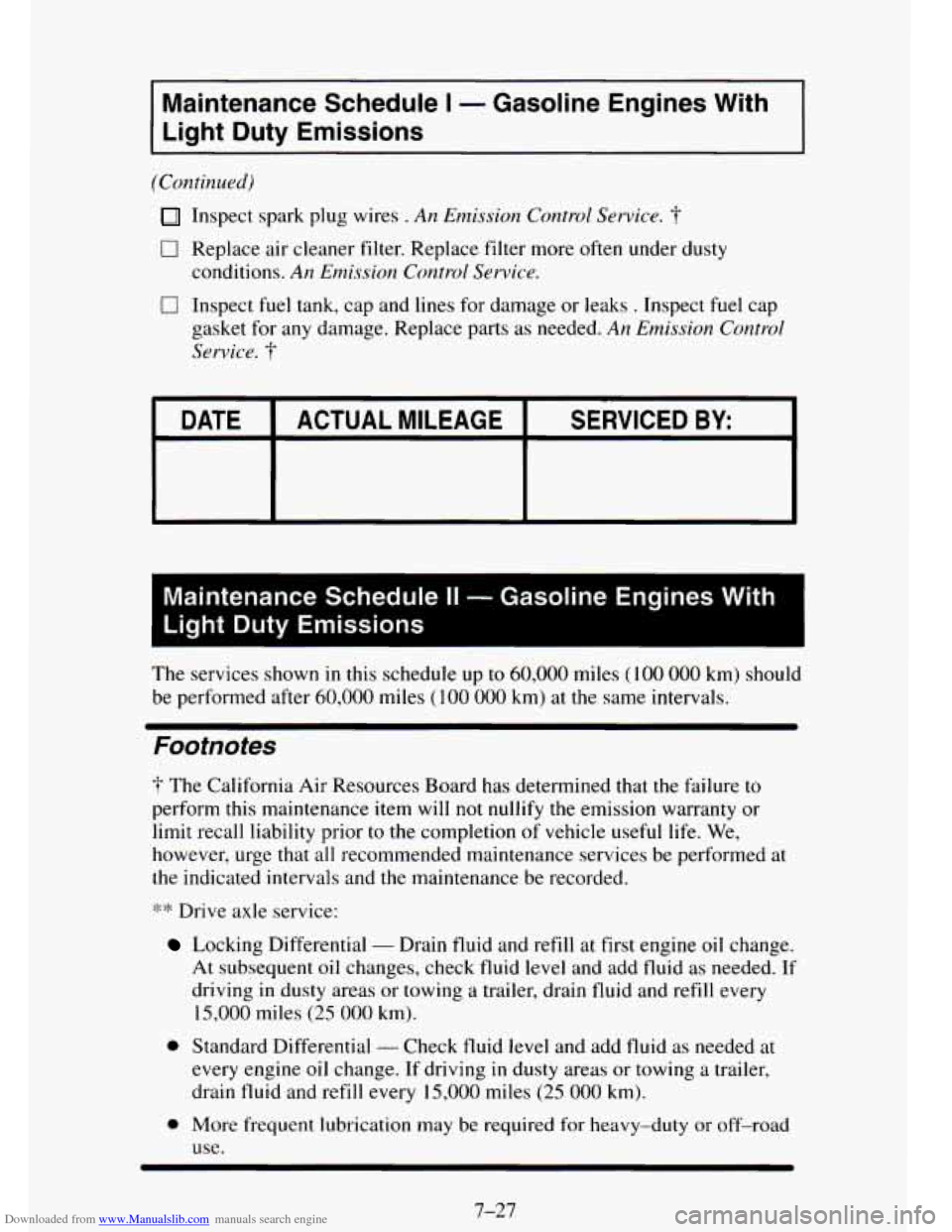
Downloaded from www.Manualslib.com manuals search engine Maintenance Schedule I - Gasoline Engines With
Light Duty Emissions
~~
(Continued)
0
0
Inspect spark plug wires . An Emission Control Service.
Replace air cleaner filter. Replace filter more often under dusty
conditions.
An Emission Control Service.
Inspect fuel tank, cap and lines for damage or leaks . Inspect fuel cap
gasket for any damage. Replace parts as needed. An
Emission Control
Sewice.
T
DATE SERVICED BY: ACTUAL MILEAGE
-
Maintenance Schedule II - Gasoline Engines With
Light Duty
Emissions
The services shown in this schedule up to 60,000 miles ( 100 000 km) should
be performed after
60,000 miles (I 00 000 km) at the same intervals.
Footnotes
T The California Air Resources Board has determined that the failure to
perform this maintenance item will not nullify the emission warranty or
limit recall liability prior
to the completion of vehicle useful life. We,
however, urge that all recommended maintenance services be performed at
the indicated intervals and the maintenance be recorded.
*4: Drive axle service:
Locking Differential - Drain fluid and refill at first engine oil change.
At subsequent oil changes, check fluid
level and add fluid as needed. If
driving
in dusty areas or towing a trailer, drain fluid and refill every
15,000 miles (25 000 km).
0 Standard Differential - Check fluid level and add fluid as needed at
every engine oil change. If driving in dusty areas or towing a trailer,
drain fluid and refill every
15,000 miles (25 000 km).
0 More frequent lubrication may be required for heavy-duty or off-road
use.
7-27
- .
Page 460 of 486
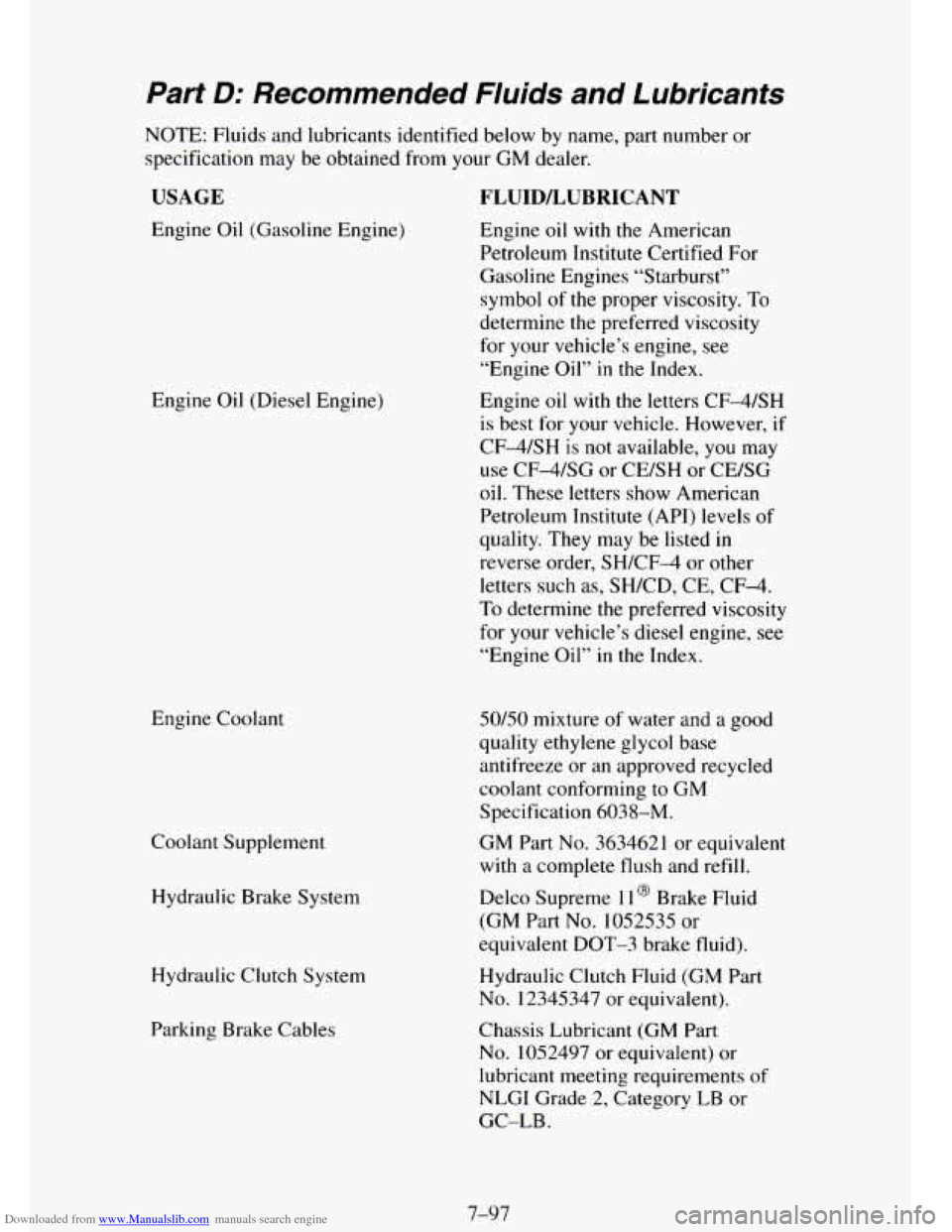
Downloaded from www.Manualslib.com manuals search engine Part D: Recommended Fluids and Lubricants
NOTE: Fluids and lubricants identified below by name, part number or
specification may be obtained from your GM dealer.
USAGE
Engine Oil (Gasoline Engine)
Engine Oil (Diesel Engine)
Engine Coolant
Coolant Supplement Hydraulic Brake System
Hydraulic Clutch System
Parking Brake Cables
FLUIDLUBRICANT
Engine oil with the American
Petroleum Institute Certified For
Gasoline Engines “Starburst”
symbol of the proper viscosity. To
determine the preferred viscosity
for your vehicle’s engine, see
“Engine Oil”
in the Index.
Engine oil
with the letters CF4SH
is best for your vehicle. However,
if
CF-4/SH is not available, you may
use CF-4/SG or CE/SH or CE/SG
oil. These letters show American
Petroleum Institute (API) levels
of
quality. They may be listed in
reverse order, SHKF-4 or other
letters such as, SH/CD, CE, CF-4.
To determine the preferred viscosity
for your vehicle’s diesel engine, see
“Engine Oil”
in the Index.
50/50 mixture of water and a good
quality ethylene glycol base
antifreeze or an approved recycled
coolant conforming to GM
Specification 6038-M.
GM Part
No. 3634621 or equivalent
with a complete flush and refill.
Delco Supreme 11 Brake Fluid
(GM Part No. 1052535 or
equivalent DOT-3 brake fluid).
Hydraulic Clutch Fluid (GM Part
No. 12345347 or equivalent).
Chassis Lubricant (GM Part
No. 1052497 or equivalent) or
lubricant meeting requirements of
NLGI Grade
2, Category LB or
GC-LB.
Page 479 of 486

Downloaded from www.Manualslib.com manuals search engine K
Key Lock Cylinders ......................................... 645. 7.93
Keyless Entry System
............................................. 2-8
Key Release Button
.............................................. 2-12
Keys
........................................................... 2-1
L
Labels
Lamps Certificationmire
(See “Certificatioflire Label”)
Center High Mounted Stop Lamp (CHMSL)
........................ 2-82
Daytime Running Lamps
....................................... 2-49
Dome
....................................................... 2-50
Headlights (See “Headlamps”)
Lamp and Bulb Data
........................................... 6-82
Reading
..................................................... 2-50
Replacement (See “Bulb Replacement”)
UnderhoodReelLamp
......................................... 2-51
Lights
Air Bag Readiness Light
........................................ 2-70
Anti-Lock Brake System Warning Light
........................... 2-72
Brake System Warning Light
.................................... 2-71
Charging System Warning Light
.................................. 2-75
Check Gages Warning Light
..................................... 2-76
Daytime Running Lamps (DRL) Indicator Light ................ 2-49, 2-76
Headlamp High Beam Indicator Light
............................. 2-77
Headlights (See “Headlamps”)
Low Coolant Warning Light ................................ 2-74, 6-36
Safety Belt Reminder Light
..................................... 2-70
Service Throttle Soon (Light Duty Diesel Engines)
................... 2-73
ShiftLight
.............................................. 2-24, 2-77
Turn Signal and Lane Change Indicator Light
.................. 2-40, 2-78
Water
in Fuel (Diesel Engine) .................................... 2-73
Loading Your Vehicle
............................................ 4-37
Lock Cylinders (See “Key Lock Cylinders”)
Loss of Control (See “Driving-Loss of Control”)
Lubrication (See “Recommended Fluids and Lubricants”)
Luggagecarrier
................................................. 2-85
GlowPlugsLight
............................................. 2-74
Malfunction Indicator (Service Engine Soon)
.................. 2-75, 6-54
TraileringPackage
............................................ 4-39
M
Malfunction Indicator Lamp (See “Lights”)
Maintenance (See “Scheduled Maintenance Services”)
Master Cylinder (See “Brakes”)
Mirrors
ConvexOutside
............................................. 2-54
Electric Outside Rearview Mirrors
................................ 2-54
Electrochromic Inside Rearview Mirror with Compass
................ 2-52
Znside
....................................................... 2-52
6